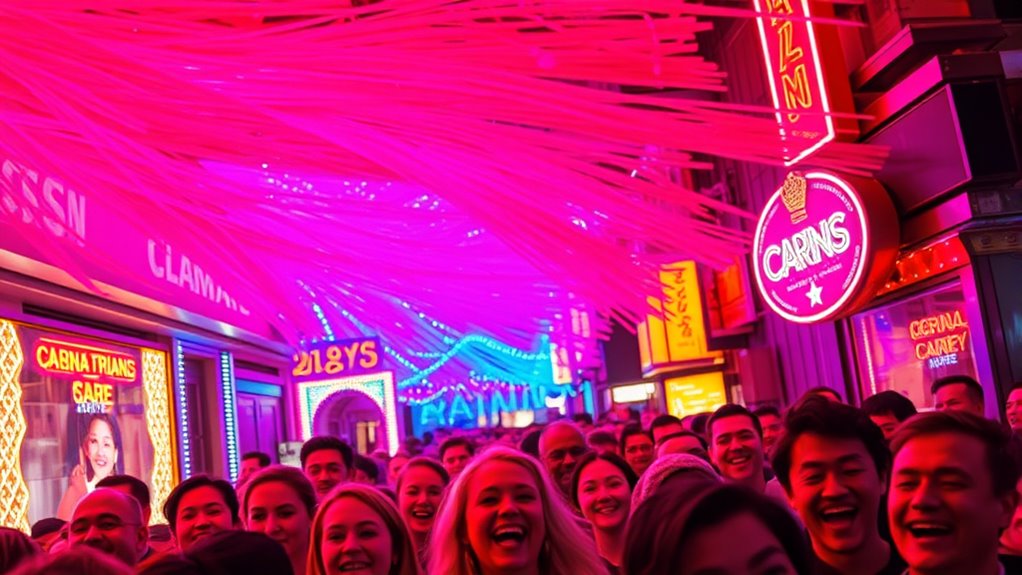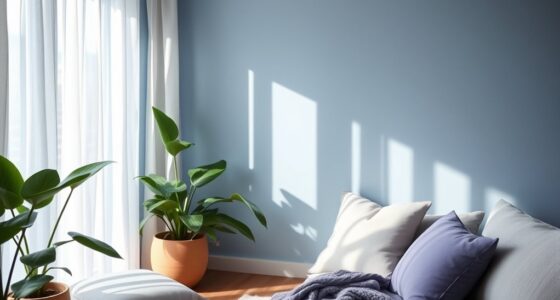Color drenching immerses you in emotionally powerful environments by flooding visuals or spaces with dominant hues. This technique uses specific colors to evoke feelings such as excitement, calm, mystery, or happiness, influencing your perceptions on a subconscious level. By intentionally choosing these hues, creators can craft moods and deepen the storytelling experience. If you want to explore how colour influences emotions and perception further, there’s much more to discover.
Key Takeaways
- Color drenching floods environments with dominant hues to evoke specific emotional responses and deepen viewer immersion.
- Bright or warm colors can energize and uplift, creating a sense of happiness and engagement in spaces or visuals.
- Cool or dark tones evoke calm, mystery, or introspection, enhancing emotional depth and narrative complexity.
- Using color psychology strategically in storytelling enhances emotional resonance and guides audience perception.
- Immersive color environments transform simple visuals into powerful narratives that evoke visceral emotional experiences.

Have you ever noticed how certain colors can instantly evoke strong emotions or alter your mood? That’s the power of color psychology at work, shaping your feelings without you even realizing it. When you’re immersed in a space or visual experience that uses color intentionally, it’s more than just aesthetics—it’s a form of visual storytelling. Colors communicate messages, set atmospheres, and influence how you interpret what’s in front of you. Whether it’s a bright red that stirs excitement or a calming blue that soothes your nerves, color has a direct line to your subconscious, guiding your emotional response.
Colors shape emotions and tell stories beyond appearance. They influence perceptions and deepen connections in visual experiences.
This is the essence of color drenching—a technique that involves flooding a space, visual design, or even a piece of artwork with a dominant hue to create a specific emotional impact. When you’re surrounded by these hues, your mind absorbs their cues, leading to a heightened emotional experience. For example, a room painted in warm yellows and oranges can energize you, sparking feelings of happiness and optimism. Conversely, deep purples and dark greens might evoke a sense of mystery or introspection. The goal is to craft an environment where color becomes a language that communicates beyond words, immersing you fully in its emotional narrative.
In the domain of visual storytelling, color drenching serves as a powerful tool. Think about movies, advertisements, or art installations—each uses vibrant hues to convey mood and deepen the narrative. When you’re watching a film scene bathed in icy blues, you’re instinctively led to feel cold or distant, enhancing the story’s emotional tone. When an ad floods the background with energetic reds, it’s designed to grab your attention and evoke passion or urgency. You become an active participant in this visual dialogue, experiencing the story not just through the visuals but through the emotional language that color provides.
Understanding the impact of color psychology allows you to leverage it intentionally. Whether you’re designing a space, creating art, or curating a brand experience, knowing how hues influence emotions helps you craft more immersive and emotionally resonant environments. Additionally, awareness of current news and social contexts can inform your color choices to better connect with your audience. When you harness the power of color drenching, you’re not just decorating—you’re telling a story, shaping feelings, and creating a visceral experience that stays with you long after you’ve looked away. This emotional immersion through hue underscores how crucial color is as a storytelling tool, capable of transforming simple visuals into profound, emotionally charged narratives.
Frequently Asked Questions
How Does Color Affect Subconscious Emotional Responses?
Color psychology influences your subconscious emotional responses by acting as emotional triggers. When you see certain hues, your mind automatically associates them with feelings like calm, excitement, or urgency. Bright reds can energize you, while soft blues promote relaxation. By understanding how colors affect emotions, you can intentionally use them to create specific moods or reactions, making your environment more emotionally resonant and aligned with your intentions.
Can Color Drenching Influence Mood Over Time?
Yes, color drenching can influence your mood over time through color therapy. By surrounding yourself with specific hues, you actively engage in mood regulation, as certain colors evoke calming or energizing feelings. Consistent exposure to these colors can gradually shift your emotional state, helping you manage stress or boost positivity. So, intentionally immersing yourself in particular shades can create lasting emotional benefits, promoting overall well-being.
What Cultural Differences Impact Color Perception Emotionally?
You might notice that cultural symbolism and color associations shape your emotional responses differently across regions. In some cultures, red symbolizes luck and prosperity, while in others, it signifies danger or passion. These cultural nuances influence how you perceive and feel about colors, creating a unique emotional landscape. Understanding these differences helps you appreciate the rich tapestry of color perception worldwide, deepening your connection to diverse cultural expressions.
How Do Individual Differences Modify Color Emotional Impact?
You find that your personal color preferences shape how colors emotionally impact you, making some hues feel more soothing or energizing. These individual differences influence how effective color therapy can be for you, as certain colors resonate more deeply based on your experiences and personality. By understanding your unique responses, you can tailor color choices to enhance well-being and emotional balance, maximizing the benefits of color therapy in your daily life.
Are There Psychological Risks Associated With Intense Color Immersion?
Diving into intense color therapy can be like walking a tightrope, with the risk of sensory overload. You might experience heightened anxiety or emotional distress if you’re overly immersed, especially if your mind is sensitive. While vibrant hues can boost mood, excessive exposure could backfire, causing psychological risks. Be mindful of your responses, and balance color immersion with calming moments to prevent emotional overwhelm.
Conclusion
As you step back and absorb the vibrant world around you, you’ll realize that color isn’t just decoration—it’s a powerful emotional force. Imagine a single hue flooding your senses, stirring feelings you didn’t know existed. What if this immersion could open hidden depths within you, revealing truths only color can unveil? The next time you see a splash of hue, ask yourself: could this be the key to unlocking your deepest emotions?









